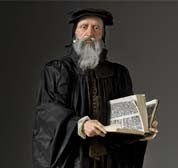Today in History: The Battle Hymn of the Republic
Julia Ward Howe, a writer, lecturer, and antislavery reformer, was visiting a Union army camp near Washington, D.C., during the Civil War when she heard soldiers singing the song “John Brown’s Body,” which began with the words “John Brown’s body lies a-moldering in the grave.” A clergyman who accompanied her suggested she write new lyrics to the tune. Howe went back to the Willard Hotel in Washington, and then, as she told it:
I went to bed and slept as usual, but awoke the next morning in the gray of the early dawn, and to my astonishment found that the wished-for lines were arranging themselves in my brain. I lay quite still until the last verse had completed itself in my thoughts, then hastily arose . . . searched for an old sheet of paper and an old stub of a pen which I had had the night before, and began to scrawl the lines almost without looking.
Howe submitted her verses—which began “Mine eyes have seen the glory of the coming of the Lord He is trampling out the vintage where the grapes of wrath are stored”—to the Atlantic Monthly which accepted them and paid her a fee of four dollars. The magazine printed the lyrics on the first page of its February 1862 issue under the title “Battle Hymn of the Republic.”
The song quickly became a favorite of the Union army. In the decades since, in times of war and peace, it has remained one of America’s most-loved hymns.
American History Parade
1846 - The Oregon Spectator, the first newspaper on the Pacific Coast of the United States, is published in Oregon City.
1913 - The Sixteenth Amendment, authorizing a federal income tax, is ratified.
1883 - The Southern Pacific Railroad opens a transcontinental “Sunset Route” from New Orleans to San Francisco.
1901 - Edwin Prescott patents a “loop-the-loop centrifugal railway”—better known as a roller coaster.
1937 - President Franklin Roosevelt proposes increasing the number of Supreme Court justices, leading critics to charge that he was trying to “pack” the court with justices to his liking.
The American Patriot's Almanac: Daily Readings on America
Labels: History





0 Comments:
Post a Comment
<< Home